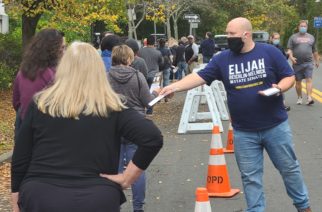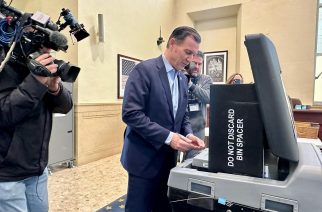
State lawmakers are alerting constituents and local community leaders that the deadline for completing the census has been moved yet again, and the sooner New Yorkers can file it, the better.
As the deadline has been a moving target, “the final schedule still remains in flux,” according to Politico. “It’s not clear when apportionment data will ultimately be finalized, including whether it would occur before Jan. 20 of next year, the presidential inauguration, which could result in a change of administrations depending on the election results.”
U.S. District Court Judge Lucy Koh issued an order on Thursday to clarify that the census is in fact still open, despite what many believe are attempts to confuse the public about the process and the deadline.
A one-sentence tweet from the U.S. Census Bureau on Sept. 28 simply stated that “The Secretary of Commerce has announced a target date of Oct. 5, 2020 to conclude 2020 Census self-response and field data collection operations.”
Sen. Liz Krueger, D-Manhattan, announced to her constituents on Monday morning “Good news! A federal court has again clarified that the deadline to complete the 2020 Census is October 31, 2020 – not October 5, 2020.”
Sen. Zellnor Myrie, D-Brooklyn, sent an update to his constituents last Wednesday noting that Judge Koh blocked the Trump Administration from ending the census count on Sept. 30.
“This ruling gives our community another month —until Oct. 31— to continue being counted and ensuring we receive our rightful share of resources and representation over the next decade.
“Brooklyn’s count still lags behind the other boroughs, and our district includes many historically-undercounted areas. We need to make this extra month count.”
Before the coronavirus swept across the United States, there was a timeline set for data collection: self-response data begins in mid-March, enumerators would begin knocking on doors in mid-May and all collections would end at the end of July with data provided, by law, to the president by Dec. 31.
Self-response data collection still began in mid-March, but due to the pandemic it has been unsafe for census takers to visit homes, as they typically do.
“We requested statutory relief from that Dec. 31 date,” said New York Regional Director of the U.S. Census Bureau Jeff Behler. “So, we would need Congress to basically state: You do not have to provide counsel to the President on Dec. 31. That was the request, to push that date to the end of April — four months later. Assuming we would’ve gotten that relief, we were going to extend data collection all the way through October.”
According to Politico, this statutory relief was never granted, and the end-of-year deadline still stands.
As of Oct. 6, New York state is approximately 99.8 percent complete, meaning that there is still 0.2 percent of the state unaccounted for — the hard-to-count communities. However, 36 percent were enumerated and some enumerated data could come from a proxy, such as a neighbor or landlord, giving the possibility for inaccurate data.
Hard-to-count communities are typically communities of color, where there is a language barrier, young children around the age of five or internet connectivity issues, Behler said.
“We need to work directly with our partners to get the word out, and knocking on doors is a great way to get those people to respond a lot of the time,” Behler said. “So we know that fear is there, it’s always their fear of government.”
Census results influence the overall allocation of $1.5 trillion a year in federal funding to schools, hospitals, roads and other vital programs, such as the Supplemental Nutrition Assistance Program (SNAP). Additionally, data from the census will provide the necessary information for redistricting and representation in the House of Representatives.
“It’s always that final 5 percent, 3 percent, 2 percent; that’s a huge number. These are our communities we’re talking about, and it makes a huge difference as to whether that community is going to get the right amount of school lunches or not,” said 2020 Census Senior Fellow Meeta Anand of the New York Immigration Coalition (NYIC), an advocacy organization that represents immigrant and refugee rights groups.
Among their efforts, the NYIC provides outreach to immigrant communities in order to educate them about the census and its importance. Their outreach includes making phone calls, sending text messages, food distribution sites and tabling in popular areas.
President Trump, however, has been accused of creating an environment of fear around his administration and other government agencies, pushing minority communities away from receiving the necessary funding to allow their communities to flourish.
Back in 2018, Commerce Secretary Wilbur Ross said there would be a citizenship question on the 2020 Census, explicitly ignoring the second clause of the 14th Amendment where it states that the reapportionment process will be done after “counting the whole number of persons in each state.”
On June 25, 2019, the Supreme Court denied the request for a citizenship question with a 5-4 vote. The majority explained that the government can ask a citizenship question, but only with justification to change the proceedings of the Census Bureau.
Chief Justice John Roberts wrote that the justification from the Trump administration was “contrived” and was not entirely genuine, hinting that this plea for change was politically driven.
Although measures of attempting to use the census for political gain were struck down by checks and balances, President Trump’s administration continued to push their agenda.
On July 21, President Trump issued a “Memorandum of Excluding Illegal Aliens From the Apportionment Base Following the 2020 Census,” on the grounds that it is necessary to obtain data on the number of citizens, noncitizens and illegal aliens in the United States. President Trump explains in this executive order that this data on illegal aliens and noncitizens could be influential in the reapportionment process, but this again goes against the Constitution.
Under Title 13 of the United States Code, the Census Bureau cannot provide data about a person, an individual or household to anyone, at any time, for any reason.
“Title 13 was put in place in 1954, and since then the Census Bureau has been taken to federal court numerous times from agencies trying to gain access to our data at the person or household level, and we have won every time,” Behler said. “There has never been a breach of Title 13 since its existence, and that is something all of our political leaders at every level of government and our partners understand — that’s the foundation of getting a complete and accurate census.”
This most recent executive order was unanimously denied by a three-judge panel in Federal District Court in Manhattan on Sept. 10, ruling that it is very illegal and President Trump’s proposal, “exceeded his authority under federal laws governing the census and reapportionment,” according to The New York Times.
“They’re weaponizing the census. They issued the policy memo, and then they shortened the census and it’s all because the administration wants to get their vision of what the apportionment data should look like,” Anand said. “They want the president to deliver a portion of data that excludes undocumented immigrants from that account, and they want that to happen on December 31. Just in case Trump loses, they don’t want the delivery of the data to creep past the date when Trump is going to be in office. They’ve shortened the census counting date and it’s all because they want to exclude undocumented immigrants in the numbers that are delivered.”
In an NPR report, emails uncovered during an investigation into the origins of the citizenship question revealed the Trump administration planned to target hard-to-count communities in order to force redistricting, thus changing the amount of seats Democratic New York has in the House, and in turn affecting representation of the state as a whole.
The administration discussed these plans with Thomas Hofeller, a redistricting expert who is influential in Republican circles, who stated in a 2015 presentation that adding a citizenship question to the census would produce data that would be “advantageous to Republicans and Non-Hispanic Whites” during redistricting. One of those advantages would be to reduce congressional representation from Democrat-leaning states like New York and, within each state, reduce representation from diverse areas, which tend to vote Democrat.
“Certainly in New York I’ve heard concerns of possibly losing two more congressional seats,” Behler said. “The census will determine the number of seats each state has in the U.S. House of Representatives, and in New York state they’ll use it for their redistricting, drawing their voting precincts, their school districts and local governments use it for their legislative districts while drawing their boundary lines.”
For low-income communities, fair representation is vital to receive the proper funding, but based on 2010 Census data, approximately 36 percent of New Yorkers live in hard-to-count neighborhoods.
“I think this administration is perfectly content to not count the hard-to-count communities as they would rather have the resources and representation go elsewhere,” Anand said.
“We knew all along that for the harder to count communities, an in-person conversation is necessary. We’ve only had a limited amount of time where groups have been comfortable being out on the ground [because of the pandemic], and to have the amount of time available to do that taken away is a crying shame, especially when a lot of these communities also represent such a large portion of the essential workers that helped us through the pandemic,” Anand added.









